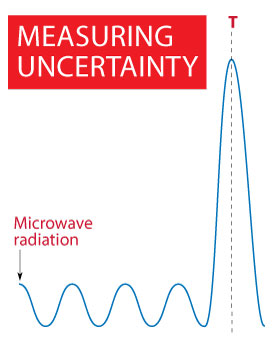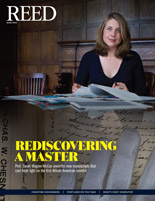
IRIS login | Reed College home Volume 94, No. 2: June 2015
Cheating Heisenberg (continued)

In Murch’s experiment, a superconducting qubit is held in quantum superposition in a sensitive microwave detector. Each small wave represents a “weak” measurement. The sharp peak at time T represents a “strong” measurement that measures (and collapses) the qubit’s state. Murch found that the weak measurements—if taken before and after T— could predict the qubit’s state at T with 90% accuracy.
Murch’s fascination with the quantum world came in part from his studies with Prof. Nicholas Wheeler ’55 [physics 1963–2010], whose musings on quantum systems often took philosophical turns. Prof. Wheeler would sometimes ask students to ponder the meaning of the concept of measurement itself.
“Back in those days,” Murch says, “I didn’t realize I’d end up devoting my whole career to understanding the measurement of quantum systems.” His Reed thesis, “The Classical Mechanics of Hoses,” addressed the theoretical underpinnings of hoses recoiling from water shooting out of a nozzle. Even today, Prof. Wheeler characterizes it as a “difficult problem” and recalls Murch’s effort as “heroic, but inconclusive.”
In addition to his physics work, Murch was an avid art student at Reed, and credits Prof. Michael Knutson [art 1982–] as “probably the most inspiring art teacher I ever had at Reed, just because he made me love abstract art.” He also worked with Prof. Gerri Ondrizek [art 1994–], whose book arts instruction helped him understand information design. “I am continually grateful for the artistic and design skills that I got,” Murch says. “Art not only guides how you design the experiment, but how you process it and show it to make the most convincing argument possible. My visual thinking, from all those art classes through the years, has been really valuable.”
Despite his largely theoretical Reed thesis, Murch’s career moved steadily away from theory and towards experimentation. This led him through doctoral and postdoctoral work with the UC Berkeley Ultracold Atomic Physics group, where he helped develop the techniques he puts to work today as an assistant professor at Washington University in St. Louis. While at Berkeley, he enjoyed a lifestyle not usually associated with quantum physics, playing cello and mandolin in local rock bands, including one that Murch classifies as an “anarchist Scottish hip-hop band.”
“We called him the ‘Swiss army knife of men,’” says Todd Snyderman, a drummer who played with Murch in two bands. “He just throws himself into everything, and he devours it, and does it better than anybody else can.” Murch also volunteered his time to teach algebra to prisoners at San Quentin State Prison with the Prison University Project. “It was the best teaching experience you can possibly imagine,” Murch says of the men’s maximum security penitentiary. “They were the most engaged, nice students . . . really nice guys. It was kinda surprising.”
With son West nearing school age, the time to put down roots arrived for Murch and his wife, Rebecca Bart ’03. A rare opportunity opened up in 2014, when she secured a position as a principal investigator at the Donald Danforth Plant Science Center in St. Louis, while Murch found a perch at Washington University. (Bart is an expert in plant genomics, having studied with Pamela Ronald ’82 at UC Davis. At the Danforth Center, she specializes in bacterial diseases of cassava and cotton.)
Murch’s most recent paper, “Prediction and Retrodiction in a Continuously Monitored Superconducting Qubit,” to be published soon as an Editor’s Suggestion in Physical Review Letters, uses weak measurements to put the two-state vector formalism to experimental proof. In his ultracold experimental chamber is a Josephson junction—a tiny wafer of aluminum oxide sandwiched between two layers of aluminum. Cooled to within a whisper of absolute zero, damped with just the right amount of capacitance, and dosed with just enough power, the system springs into a stable quantum state, becoming a qubit, an artificial atom that offers the advantage of not jumping around when superposed. The chamber itself is a highly tuned microwave sensor that can pick up infinitesimal changes in the electrical field surrounding the qubit. The detector can sense a fluctuation in the qubit’s electric field of 10–16 watts—about a hundred-trillionth of the energy a butterfly uses to flap its wings.
In action, the experiment weakly measures the qubit every 20 billionths of a second. These measurements are so small they give back very little information about the quantum state, like a sputtering candle casting faint shadows in a dark cave. While these measurements yield little useful data, they’re so weak than they don’t disturb the quantum state either. After about a hundred weak measurements over a millionth of a second, the experiment “turns on the lights” for an instant, taking a strong measurement that annihilates the quantum superposition and measures the qubit. It records the result: heads or tails. Then, weak measurements continue every 20 nanoseconds for another microsecond after the strong measurement.
Using two-state vector formalism and without peeking at the results of the strong measurements, Murch found that he could analyze the before-and-after weak measurements, each no better than a random guess, and correctly guess the strong measurement 90% of the time. The observer effect says that’s not supposed to happen. Weirder still, the calculations only work when weak measurements before and after the quantum collapse are taken into account. The obvious interpretation: as Aharonov predicted, information about the quantum collapse leaks into the strong measurement from both the past and the future.
The experiment provoked international attention in the media—intense, hyperbolic, and often just plain wrong. “Can the Past be Changed by the FUTURE? Bizarre Quantum Experiment Suggests Time Can Run Backwards,” exclaimed the London Daily Mail. Blogs as far away as Pakistan proclaimed the invention of time travel. For his part, Murch is considerably more restrained. “When you read the paper, we’re very careful about what we say,” Murch says. “We don’t claim ‘the future affects the past’ in PRL.”
“I’m not sure I’m really in favor of reverse causation,” Murch sighs. “You can do all of this without some sort of fancy time-symmetric approach. In fact, normally . . . we have operators called ‘positive operator value’ measures that [can] deal with the measurement in a rigorous way.”
“That’s true of many interpretations of quantum mechanics,” notes coauthor Andrew Jordan, of the University of Rochester. “For example, the ‘many worlds’ interpretation or the Bohmian interpretation or any other of a half a dozen interpretations—they all agree on the answers, but disagree on how you think about it.”
“It’s just a different way of looking at the math,” Murch says. “It does lend itself to some more intuitive ways to approach the problem, and that’s sort of the two-state vector formalism.” In other words, information could be leaking back in time . . . unless you explain the system using different, much more convoluted math.
The 13th-century philosopher William of Occam famously proposed that the simplest explanation is usually the correct one. Whether information leaking backward in time is a simpler explanation than linear time (with much hairier math) is open to discussion. No instrument yet invented can detect what Occam would make of it all.
- Previous Page
- 1
- 2
- Next Page

LATEST COMMENTS
steve-jobs-1976 I knew Steve Jobs when he was on the second floor of Quincy. (Fall...
Utnapishtim - 2 weeks ago
Prof. Mason Drukman [political science 1964–70] This is gold, pure gold. God bless, Prof. Drukman.
puredog - 1 month ago
virginia-davis-1965 Such a good friend & compatriot in the day of Satyricon...
czarchasm - 4 months ago
John Peara Baba 1990 John died of a broken heart from losing his mom and then his...
kodachrome - 7 months ago
Carol Sawyer 1962 Who wrote this obit? I'm writing something about Carol Sawyer...
MsLaurie Pepper - 8 months ago
William W. Wissman MAT 1969 ...and THREE sisters. Sabra, the oldest, Mary, the middle, and...
riclf - 10 months ago